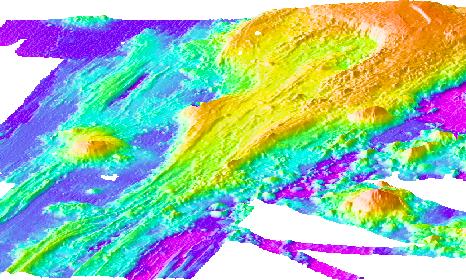
The CoAxial segment of the Juan de Fuca Ridge was the site of the first deep-sea volcanic eruption that was detected as it was happening. Earthquakes associated with the intrusion of magma were detected by the PMEL T-phase monitoring system in June/July 1993. . Within weeks of the start of the earthquake swarm a NOAA research vessel was at the site and found large hydrothermal "event" plumes over the area where the seismicity had been most prolonged and intense. When the ROPOS ROV was used to dive on this site, a brand new lava flow was discovered on the seafloor. The new lava flow was still hot and venting warm water (up to 50°C) and is 2.5 km long and 300 m wide. Bright yellow sediment patches on the new lava indicated the presence of iron-reducing bacteria in the vent fluids. Other sites along the path of the dike intrusion where also venting warm water and some sites spewed large amounts of bacterial floc into the water, looking like snowblowers. Hyperthermophilic bacteria (bacteria that live at temperatures up to 90°C) were present in the vent fluids from this site. Apparently the dike intrusion produced a sudden bloom in the subsurface biosphere, and some of this explosion of new life was expelled out onto the seafloor. Subsequent investigations at the CoAxial segment include repeat SeaBeam surveys in 1993, extensive towed camera surveys in 1994, deep-towed high resolution sidescan surveys in 1996, and Alvin dive programs in 1993, 1994, and 1995. More information about this event can be found on the CoAxial Homepage. Movies of the earthquake swarm, the edge of the lava flow, venting on the new lava, a snowblower vent, and biological colonization, are available on the Video page.
Results from investigations at the CoAxial segment were published in a special issue of Geophysical Research Letters (vol. 22, no. 2, January 15, 1995, p. 129-182), and other work in still in progress. The following are some selected scientific papers on the geology of the CoAxial segment:
Embley, R. W., W. W. Chadwick, Jr., M. R. Perfit, M. C. Smith, and J. R. Delaney, Recent eruptions on the CoAxial segment of the Juan de Fuca Ridge: Implications for mid-ocean ridge accretion processes, J. Geophys. Res., 105, 16501-16525, 2000.
Chadwick, W. W., Jr., R. W. Embley, and C. G. Fox, SeaBeam depth changes associated with recent lava flows, CoAxial segment, Juan de Fuca Ridge: Evidence for multiple eruptions between 1981-1993, Geophys. Res. Lett., 22, 167-170, 1995.
Embley, R. W., W. W. Chadwick Jr., I. R. Jonasson, D. A. Butterfield, and E. T. Baker, Initial results of the rapid response to the 1993 CoAxial event: Relationships between hydrothermal and volcanic processes, Geophys. Res. Lett., 22, 143-146, 1995.
Fox, C. G., W. E. Radford, R. P. Dziak, T. K. Lau, H. Matsumoto, and A. E. Schreiner, Acoustic detection of a seafloor spreading episode on the Juan de Fuca Ridge using military hydrophone arrays, Geophys. Res. Lett., 22, 131-134, 1995.
Holden, J. F., B. C. Crump, M. Summit, and J. A. Baross, Microbial blooms at the CoAxial segment, Juan de Fuca Ridge deep-sea hydrothermal vent site following a magma intrusion, 76, 43, Fall Meeting suppl., 1995.
Juniper, S. K., P. Martineu, J. Sarrazin, and Y. Gélinas, Microbial-mineral floc associated with nascent hydrothermal activity on CoAxial segment, Juan de Fuca Ridge, Geophys. Res. Lett., 22, 179-182, 1995.
last modified on 11/09/01 by Bill Chadwick
